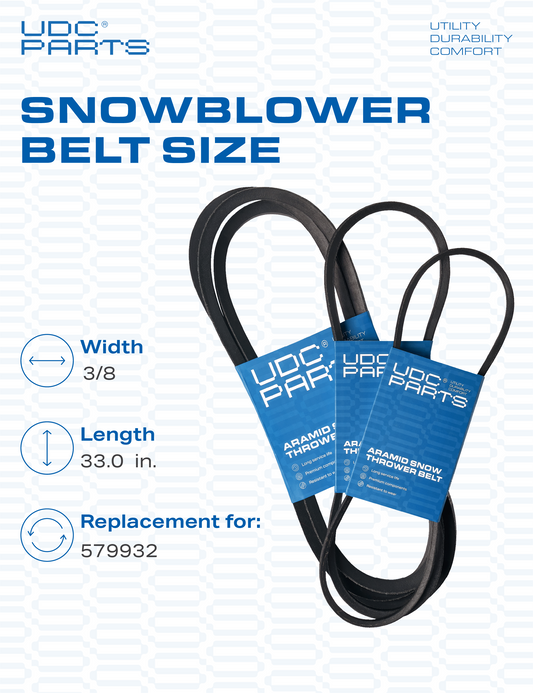
Pulling your starter rope over and over, desperately trying to get your snowblower to run during the first snowfall of the season? We don't want you doing that. And we'll give you some valuable snowblower maintenance tips that will save you a lot of hassle.
Why Snow Blower Maintenance is Crucial
Remember, there can be no compromise when clearing snow and snow blower maintenance will help keep your equipment exactly in peak shape. It also helps to extend the overall longevity of your equipment.
Prepare Your Snow Blower: Key Tasks Before the Snow Hits
As the main task, we can mention draining the gasoline before the end of the season and draining it in advance before the start of the season. But there are many more things as well.
Replace the Spark Plug
Worth performing if you feel that the snow blower has trouble starting.
Check and Adjust the Belts
A snow blower is the kind of machine that has a huge number of bolted assemblies. It's best to double-check all such connections. You certainly don't want such parts to get inside the engine when it's active.
Inspect and Clean the Paddles
Inspect the paddles carefully, clean them thoroughly, or decide if replacements are needed. This consumable part requires replacement on average every few years.
Adjust or Replace the Skid Shoes
The task of the skid shoes is to protect the shave plate from wear and tear, to which it is highly susceptible. Place the snow blower on a flat surface and check that there is an even air gap all across the shave plate. Make adjustments if necessary.
Inspect Shear Pins for Damage
Turn the snow blower over and secure it to the stand so you don't hurt your back. Shear pins will be in the center of the construction, pull them out, wipe dry of dirt and check for damage. Apply grease or remove if necessary.
Change the Engine Oil
Run the snow blower for a couple of minutes to warm up the oil, unplug the machine, take the form of a funnel and place it under an oil spout, lift the snow blower and secure it with e.g. wooden blocks, take a socket, stick it to a drain plug and loosen it up. Now the old oil will flow freely. Use the funnel and fill in the correct amount of new oil.
Add Fresh Gas with Fuel Stabilizer
Gasoline can break down over time, and fuel stabilizers just keep it fresh and can extend it for a year or more. But in the off-season, it is advisable to drain the gasoline completely.

Storing Your Snow Blower Properly
The machine should be stored in a closed place with temperatures at least close to room temperature.
Clean the Snow Blower Thoroughly
Carburetors, chutes, wheels, handlebars are those parts that require extra attention. Use WD-40 or rust inhibitors to treat most of them. This will protect your snow blower even in the most unfavorable conditions.
Drain or Stabilize Fuel
If you have been using stabilizers for a long time and at the start of the season your snow blower starts up and does its job as usual, then you are fine. If not, it is better to drain the gasoline.
Change the Oil
Oil change is one of the basic elements in snow blowers maintenance. Its Color will tell you the current situation. It is sufficient to use a gauge or drain some fluid for evaluation.
Inspect and Replace Parts
Spark plug, paddles, scraper bar, skid shoes, shear pins and auger belt are the consumables you should inspect and replace if needed.
Store in a Dry, Covered Area
Great advice, to which we would also add the floor surface. Your snow blower tires will not be very comfortable on concrete.
Check the Battery
In the case of electric models, all consumables take a back seat to the battery.
Cover the Snow Blower
Dust is really a big problem, especially in areas like garages. Use a dense cover of the right size.
Troubleshooting Common Snow Blower Problems
Do not mishandle gasoline in any way: never do not prime a warm engine. Always check the fuel and that it is not contaminated. When was the last time you changed it actually?
Snow Blower Fails to Start
Instructions are next: Make sure your spark plug connection is tight. Check the actual spark plug if it still doesn't work. Still not running? Check the belts, another common problem.
Engine Stalls After Brief Operation (Gas Models)
It actually can be anything: fuel supply issues, air intake problems, overheating. Consult a service snow blower if the cause cannot be found.
Engine Runs Roughly (Gas Models)
Again, it can be anything: carburetor issues with gas models or electrical issues with the latest e-models. Snowblower annual maintenance should cut down on the list of possible problems.
Auger or Paddles Won't Turn While Running
The issue can be with drive belt, clutch, gearbox, auger shear pins, motor or electrical problems (for electric start models).
Leaves Behind Snow After Clearing
In this case, the problem could be in improper auger height, worn blades, or even your clearing technique. You may be shoveling snow too fast.
Poor Snow Discharge Performance
Clogged discharge chute or worn or dull auger blades can be the reason for this specific problem.

UDC Parts: Your Partner in Snow Blower Maintenance
Starting in 2019, we are proud to make dependable parts for your garden equipment. Thousands of operators already appreciate the quality of our products, the ease of ordering and our competitive prices. It will be much easier to go through a snowblower maintenance checklist with UDC Parts.
Conclusions
About 8 regular actions to change fluids and components and you'll be fine. Or you can trust the experts.





















